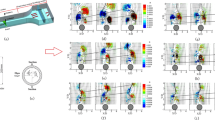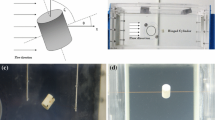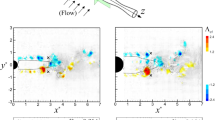Abstract
The wake flows behind fixed, hollow, rigid circular cylinders with two rows of holes connecting the front and rear stagnation lines were investigated using particle image velocimetry (PIV) for various combinations of three hole diameters, d = 0.1D, 0.15D, and 0.20D, six hole-to-hole distances, l = 2d, 3d, 4d, 5d, 6d, and 7d, and ten angles of incidence (α), from 0° to 45° in steps of 5°, at a Reynolds number of Re = 6,900. Time-averaged velocity distributions, instantaneous and time-averaged vorticity patterns, time-averaged streamline topology, and hot spots of turbulent kinetic energy occurred through the interaction of shear layers from the models were presented to show how the wake flow was modified by the presence of the self-issuing jets with various momentums emanating from the downstream holes. In general, as hole diameter which is directly related to jet momentum increased, the values of time-averaged wake characteristics (length of time-averaged recirculation region, vortex formation length, length of shear layers, and gap between the shear layers) increased. Irrespective to d and l tested, the values of the vortex formation length of the models are greater than that of the cylinder without hole (reference model). That is, vortex formation process was shifted downstream by aid of jets. It was found that time-averaged wake characteristics were very sensitive to α. As α increased, the variation of these characteristics can be modeled by exponential decay functions. The effect of l on the three-dimensional vortex shedding patterns in the near wake of the models was also discussed.
























Similar content being viewed by others
Abbreviations
- A:
-
Amplitude (mm/s)
- AR:
-
Aspect ratio
- BR:
-
Blockage ratio
- d:
-
Diameter of the hole (m)
- D:
-
Diameter of the cylinder (m)
- f:
-
Vortex shedding frequency (Hz)
- F:
-
Focus
- Fr:
-
Froude number
- FOV:
-
Field of view
- g:
-
Gravitational acceleration (m/s2)
- G:
-
Gap (m)
- H:
-
Height (m)
- HD:
-
Hydraulic diameter (m)
- L:
-
Length (m)
- l:
-
Distance between the hole centers (m)
- N:
-
Node
- q:
-
Quantity
- Re:
-
Reynolds number
- St:
-
Strouhal number
- TI:
-
Turbulence intensity
- k:
-
Nondimensional turbulent kinetic energy
- n:
-
Number of holes drilled on the model
- u, v, w:
-
Streamwise, transverse and spanwise components of the velocity (m/s)
- w:
-
Width (m)
- U:
-
Velocity (m/s)
- x, y, z:
-
Streamwise, transverse and spanwise coordinate directions (m)
- 〈..〉:
-
The average over time of the enclosed quantity
- α:
-
Angle of incidence (°)
- Γ:
-
Nondimensional vorticity
- µ:
-
Dynamic viscosity of the water (kg/m/s)
- ρ:
-
Density of the water (kg/m3)
- ω:
-
Vorticity (1/s)
- ave:
-
Spanwise averaged
- C:
-
Cylinder
- Clo:
-
Wake closure
- Ch:
-
Water channel
- Cr:
-
Critical
- F:
-
Vortex formation
- Fro:
-
Frontal
- h:
-
Hole
- J:
-
Jet
- max:
-
Maximum
- p:
-
Plate
- P:
-
Penetration
- R:
-
Recirculation
- S:
-
shear layer
- w:
-
Water
- ∞:
-
Freestream
- ′:
-
Fluctuating component
References
Akansu YE, Firat E (2010) Control of flow around a square prism by slot jet injection from the rear surface. Exp Therm Fluid Sci 34:906–914
Aydın BT, Cetiner O, Unal MF (2010) Effect of self-issuing jets along the span on the near-wake of a square cylinder. Exp Fluids 48:1081–1094
Baek H, Karniadakis GE (2009) Suppressing vortex-induced vibrations via passive means. J Fluid Struct 25:848–866
Beahan JJ, Shih C, Krothapalli A, Kumar R, Chandrasekhara MS (2014) Compressible dynamic stall control using high momentum microjets. Exp Fluids 55:1813
Bloor MS (1964) The transition to turbulence in the wake of a circular cylinder. J Fluid Mech 19(2):290–304
Chen H, Rao F, Shang X, Zhang D, Hagiwara I (2014) Flow over bio-inspired 3D herringbone wall riblets. Exp Fluids 55:1698
Chen W-L, Gao D-L, Yuan W-Y, Li H, Hu H (2015) Passive jet control of flow around a circular cylinder. Exp Fluids 56:201
Choi H, Jeon W-P, Kim J (2008) Control of flow over a bluff body. Annu Rev Fluid Mech 40:113–139
Chyu C-K, Rockwell D (2002) Near-wake flow structure of a cylinder with a helical surface perturbation. J Fluid Struct 16(2):263–269
Cuhadaroglu B, Akansu YE, Turhal AO (2007) An experimental study on the effects of uniform injection through one perforated surface of a square cylinder on some aerodynamic parameters. Exp Therm Fluid Sci 31:909–915
Dong S, Triantafyllou GS, Karniadakis GE (2008) Elimination of vortex streets in bluff body flows. Phys Rev Lett 100:204501
Fu H, Rockwell D (2005) Shallow flow past a cylinder: control of the near wake. J Fluid Mech 539:1–24
Goruney T, Rockwell D (2009) Flow past a delta wing with a sinusoidal leading edge: near-surface topology and flow structure. Exp Fluids 47:321–331
Grosche F-R, Meier GEA (2001) Research at DLR Göttingen on bluff body aerodynamics, drag reduction by wake ventilation and active flow control. J Wind Eng Ind Aerod 89:1201–1218
Hangan H, Kim J (2003) Aerodynamic slot-control for 2D square prisms. J Wind Eng Ind Aerod 91:1847–1857
He GS, Li N, Wang JJ (2014) Drag reduction of square cylinders with cut-corners at the front edges. Exp Fluids 55:1745
Hu H, Koochesfahani MM (2011) Thermal effects on the wake of a heated circular cylinder operating in mixed convection regime. J Fluid Mech 685:235–270
Hu T, Wang Z, Gursul I (2014) Passive control of roll oscillations of low-aspect-ratio wings using bleed. Exp Fluids 55:1752
Igarashi I (1978) Flow characteristics around a circular cylinder with a slit. B JSME 21(154):656–664
Kato K, Breitsamter C, Obi S (2014) Flow separation control over a GÖ 387 airfoil by nanosecond pulse-periodic discharge. Exp Fluids 55:1795
Kim D-H, Yang K-S, Eom J-S (2003) Confined vortex shedding past a square cylinder with a planar jet. JSME Int J B-Fluid T 46(2):316–325
Konstantinidis E, Balabani S, Yianneskis M (2003) The effect of flow perturbations on the near wake characteristics of a circular cylinder. J Fluid Struct 18:367–386
Kwon SJ, Seo IW (2005) Reynolds number effects on the behavior of a non-buoyant round jet. Exp Fluids 38:801–812
Levy B, Friedrich H, Cater JE, Clarke RJ, Denier JP (2014) The impact of twine/mesh ratio on the flow dynamics through a porous cylinder. Exp Fluids 55:1829
Lin J-C, Rockwell D (1997) Quantitative interpretation of vortices from a cylinder oscillating in quiescent fluid. Exp Fluids 23:99–104
Mao X, Blackburn HM, Sherwin SJ (2015) Nonlinear optimal suppression of vortex shedding from a circular cylinder. J Fluid Mech 775:241–265
Mavridis C, Bakrozis A, Koutmos P, Papailiou D (1998) Isothermal and non-premixed turbulent reacting wake flows past a two-dimensional square cylinder. Exp Therm Fluid Sci 17:90–99
Menicovich D, Lander D, Vollen J, Amitay M, Letchford C, Dyson A (2014) Improving aerodynamic performance of tall buildings using fluid based aerodynamic modification. J Wind Eng Ind Aerod 133:263–273
Moffat RJ (1985) Using uncertainty analysis in the planning of an experiment. J Fluid Eng-T ASME 107:173–178
Moffat RJ (1988) Describing the uncertainties in experimental results. Exp Therm Fluid Sci 1:3–17
Murai Y (2014) Frictional drag reduction by bubble injection. Exp Fluids 55:1773
Najafi L, Firat E, Akilli H (2016) Time-averaged near-wake of a yawed cylinder. Ocean Eng 113:335–349
Norberg C (1998) LDV-measurements in the near wake of a circular cylinder. 1st BBVIV Conference, Washington DC, USA
Pinar E, Ozkan GM, Durhasan T, Aksoy MM, Akilli H, Sahin B (2015) Flow structure around perforated cylinders in shallow water. J Fluid Struct 55:52–63
Reichl P, Hourigan K, Thompson MC (2005) Flow past a cylinder close to a free surface. J Fluid Mech 533:269–293
Samani M, Bergstrom DJ (2015) Effect of a wall on the wake dynamics of an infinite square cylinder. Int J Heat Fluid Fl 55:158–166
Schmidt H-J, Woszidlo R, Nayeri CN, Paschereit CO (2015) Drag reduction on a rectangular bluff body with base flaps and fluidic oscillators. Exp Fluids 56:151
Sheng J, Meng H, Fox R (2000) A large eddy PIV method for turbulence dissipation rate estimation. Chem Eng Sci 55(20):4423–4434
Shi X-D, Feng L-H (2015) Control of flow around a circular cylinder by bleed near the separation points. Exp Fluids 56:214
Sohankar A, Khodadadi M, Rangraz E (2015) Control of fluid flow and heat transfer around a square cylinder by uniform suction and blowing at low Reynolds numbers. Comput Fluids 109:155–167
Specialist Committee on Uncertainty Analysis of 25th ITTC (2008) Recommended procedures and guidelines: uncertainty analysis particle imaging velocimetry. 25th ITTC, Fukuoka, Japan
Stanislas M, Okamoto K, Kähler CJ, Westerweel J (2005) Main results of the second international PIV challenge. Exp Fluids 39:170–191
Wang XK, Tan SK (2008) Near-wake flow characteristics of a circular cylinder close to a wall. J Fluids Struct 24:605–627
Wang XK, Zhang J-X, Hao Z, Zhou B, Tan SK (2015) Influence of wall proximity on flow around two tandem circular cylinder. Ocean Eng 94:36–50
Westerweel J, Elsinga GE, Adrian RJ (2013) Particle image velocimetry for complex and turbulent flows. Annu Rev Fluid Mech 45:409–436
Wong HY (1985) Wake flow stabilization by the action of base bleed. J Fluids Eng 107(3):378–384
Yajima Y, Sano O (1996) A note on the drag reduction of a circular cylinder due to double rows of holes. Fluid Dyn Res 18:237–243
Zhang MM, Wang GF, Xu JZ (2014) Experimental study of flow separation control on a low-Re airfoil using leading-edge protuberance method. Exp Fluids 55:1710
Zhang J, Tian H, Yao Z, Hao P, Jiang N (2015) Mechanism of drag reduction of superhydrophobic surfaces in a turbulent boundary layer flow. Exp Fluids 56:179
Author information
Authors and Affiliations
Corresponding author
Rights and permissions
About this article
Cite this article
Firat, E., Ozkan, G.M. & Akilli, H. PIV measurements in the near wakes of hollow cylinders with holes. Exp Fluids 58, 39 (2017). https://doi.org/10.1007/s00348-017-2334-x
Received:
Revised:
Accepted:
Published:
DOI: https://doi.org/10.1007/s00348-017-2334-x




